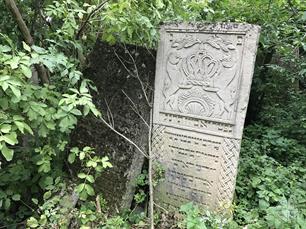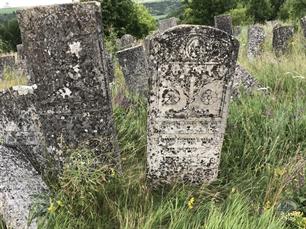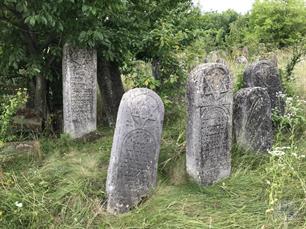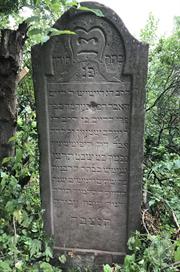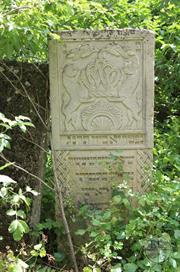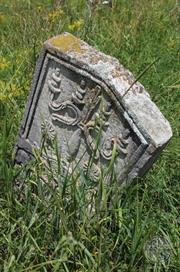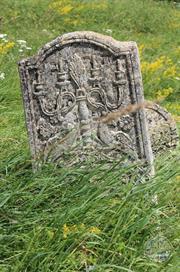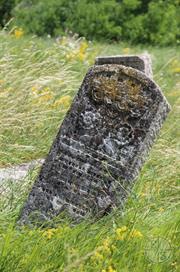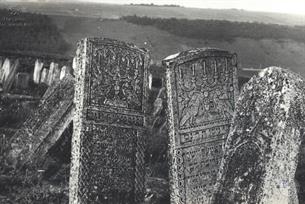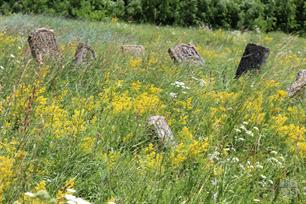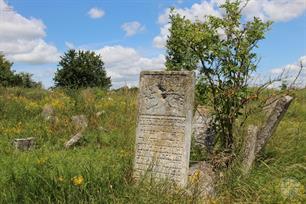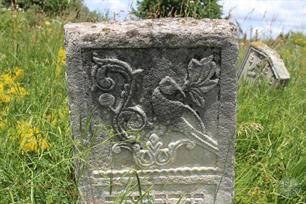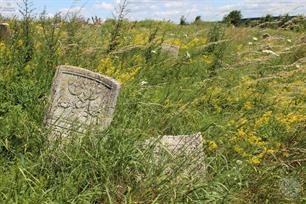Korolivka
Chortkiv district, Ternopil region
Sources:
- Pinkas Hakehillot Polin: Encyclopedia of Jewish Communities, Poland, Volume II, pages 489-490, published by Yad Vashem, Jerusalem. Translated by Amy Samin, JewishGen, Inc.
Photo:
- Michael Kheifetz, Eva Maria Kraiss, Hryhoriy Arshynov - Center for Jewish Art, Korolivka
- Pinkas Hakehillot Polin: Encyclopedia of Jewish Communities, Poland, Volume II, pages 489-490, published by Yad Vashem, Jerusalem. Translated by Amy Samin, JewishGen, Inc.
Photo:
- Michael Kheifetz, Eva Maria Kraiss, Hryhoriy Arshynov - Center for Jewish Art, Korolivka
Year - Total Population - Jews
1900 - 3,576 - 1,596
1921 - 3,081 - 1,161
1900 - 3,576 - 1,596
1921 - 3,081 - 1,161
Korolуwka (ukr. Korolivka, Королівка) was located twelve kilometers from Borszczуw; it was apparently founded in the 17th century and was privately owned by the members of a noble family. The town began to develop in the 18th century and grew particularly well in the 19th century. At the end of that century, Korolуwka was connected to the railroad. Next to the town was the castle of the estate holders. After the town was damaged during the Russian occupation of 1914 – 1917, the population declined.
The Jewish settlement was apparently established at the end of the 17th century or the beginning of the 18th century. The wooden synagogue, the foundations of which date from the 18th century, attest to that. The synagogue remained standing until the 19th century. In 1726 Yaacov Leibovitch Frank, the founder of the Frankist sect, was born in Korolуwka and dwelled there until the age of twelve. The Jewish settlement grew and developed in the 19th century, despite the fact that it always remained overshadowed by the communities of Borszczуw and Brzeźany [today – Berezhany]. In 1904 a fire consumed about 30 Jewish homes. Jews from Brzeźany came to the aid of their neighbors, bringing them food. After the destruction of the town by the occupying Russians (not a single working well remained in the town) another fire struck the town and burned approximately 30 homes in which 38 Jewish families had lived.
The first Jewish settlers dealt in leasing and commerce (in the 18th century also in commerce with Walachia), and in the 19th century in small trade, peddling in the villages, and handwork. No significant changes occurred in the professional make-up of the Jews of Korolуwka during the period between the two world wars. We can learn this from the professions of those taking out loans, which appear in the benefit society fund's records (the fund was founded in 1929 and distributed loans as follows: 1935 – 1936 202 loans in an amount totaling 11,197 zloty, and in 1936 – 1937 217 loans totaling 15,090 zloty). Of those who received the loans 16 were workshop owners, 78 were small merchants and peddlers, 4 were workers who earned a daily wage, 15 farmers and 12 others.
In the 1930s the economic situation of the Jews of Korolуwka worsened; the merchants were forced into a difficult competition with the Ukrainian cooperatives, and anti-Semitic incitement was on the rise both in the town and in the surrounding villages. In May of 1937 a Jewish family was murdered in a nearby village, and in other villages Jews received threatening letters. In April of 1939 the Jewish owner of an oil producing factory was beaten. When the edict regarding the slaughtering of animals was passed down in 1937 in Poland, the authorities would not allow even one kosher butcher shop. The butchers were left without the means of earning a living, and the Jews were forced to bring in meat from Borszczуw.
The Jewish settlement was apparently established at the end of the 17th century or the beginning of the 18th century. The wooden synagogue, the foundations of which date from the 18th century, attest to that. The synagogue remained standing until the 19th century. In 1726 Yaacov Leibovitch Frank, the founder of the Frankist sect, was born in Korolуwka and dwelled there until the age of twelve. The Jewish settlement grew and developed in the 19th century, despite the fact that it always remained overshadowed by the communities of Borszczуw and Brzeźany [today – Berezhany]. In 1904 a fire consumed about 30 Jewish homes. Jews from Brzeźany came to the aid of their neighbors, bringing them food. After the destruction of the town by the occupying Russians (not a single working well remained in the town) another fire struck the town and burned approximately 30 homes in which 38 Jewish families had lived.
The first Jewish settlers dealt in leasing and commerce (in the 18th century also in commerce with Walachia), and in the 19th century in small trade, peddling in the villages, and handwork. No significant changes occurred in the professional make-up of the Jews of Korolуwka during the period between the two world wars. We can learn this from the professions of those taking out loans, which appear in the benefit society fund's records (the fund was founded in 1929 and distributed loans as follows: 1935 – 1936 202 loans in an amount totaling 11,197 zloty, and in 1936 – 1937 217 loans totaling 15,090 zloty). Of those who received the loans 16 were workshop owners, 78 were small merchants and peddlers, 4 were workers who earned a daily wage, 15 farmers and 12 others.
In the 1930s the economic situation of the Jews of Korolуwka worsened; the merchants were forced into a difficult competition with the Ukrainian cooperatives, and anti-Semitic incitement was on the rise both in the town and in the surrounding villages. In May of 1937 a Jewish family was murdered in a nearby village, and in other villages Jews received threatening letters. In April of 1939 the Jewish owner of an oil producing factory was beaten. When the edict regarding the slaughtering of animals was passed down in 1937 in Poland, the authorities would not allow even one kosher butcher shop. The butchers were left without the means of earning a living, and the Jews were forced to bring in meat from Borszczуw.
Of the rabbis of the town we will mention Rav Avraham-Abush Eisner, a native of Korolуwka who was the holy leader in Huєi in Romania, in Grуdek Jagielloński [today - Horodok] and in Korolуwka. He was well-educated and participated in “HaMagid” and “HaTzfirah.” In his articles on the ways of Jewish education he advocated the establishment of schools for the children of Israel of the sort run by the company Alliance Israйlite Universelle.
In 1877 he retired from the rabbinate in Korolуwka and opened a bookstore there. He founded the magazine Hatzofeh (the Spectator); only two issues were ever published, both in 1878.
In 1879 he moved his shop to Czerniowce [today – Chernivtsi] in Bukovina.
For many years the office of rabbi of Korolуwka was held by Haim bar Yaacov-Shimon Rozenberg, who was appointed in 1884 and continued to serve as the rabbi through the period between the two world wars.
As a result of his opposition to Zionism, there were no organized Zionist groups in Korolуwka until World War I. However, through the efforts of some of the well-educated people in the town, including among others the doctor Lazar Fierstein, in the last years of the 19th century or first years of the 20th century, a school founded on the principles of Baron Hirsch was established.
At the end of the First World War, after the rule of the Republic of Western Ukraine in the town from 1918 – 1919, and after the withdrawal of the Bolsheviks in 1920 and after the Polish government was formed, the Zionists of the area began their activities in earnest. At first they organized on behalf of the refugees who came to Korolуwka from the Ukraine; with the passage of time branches of the Histadrut HaZioni (Zionist Union) and various youth movements such as Hashomer Hazair (the Young Guard), Hanoar Hazioni (Zionist Youth), Beitar and Gordonia also appeared in the town. In 1925 a branch of Ezra was created. During the period of growth, the group Hovevai Tarbut (Culture Enthusiasts) was active and there were libraries and drama classes which existed alongside the youth organizations.
In 1935 a comprehensive Hebrew school was established in the town.
In the 1927 elections for the city council twenty-two Jews were elected (out of a total of forty-eight seats), many of whom were Zionists. One of these was N. Gelbard, who was elected vice mayor of the city. In the Zionist Congress elections of 1935, the people voted as follows: General Zionists – 202, Mizrachi – 13, Eretz Yisrael Ha'ovedet – 137. In 1939 79 shekels were sold, although the elections for the Congress did not take place in Korolуwka.
In 1877 he retired from the rabbinate in Korolуwka and opened a bookstore there. He founded the magazine Hatzofeh (the Spectator); only two issues were ever published, both in 1878.
In 1879 he moved his shop to Czerniowce [today – Chernivtsi] in Bukovina.
For many years the office of rabbi of Korolуwka was held by Haim bar Yaacov-Shimon Rozenberg, who was appointed in 1884 and continued to serve as the rabbi through the period between the two world wars.
As a result of his opposition to Zionism, there were no organized Zionist groups in Korolуwka until World War I. However, through the efforts of some of the well-educated people in the town, including among others the doctor Lazar Fierstein, in the last years of the 19th century or first years of the 20th century, a school founded on the principles of Baron Hirsch was established.
At the end of the First World War, after the rule of the Republic of Western Ukraine in the town from 1918 – 1919, and after the withdrawal of the Bolsheviks in 1920 and after the Polish government was formed, the Zionists of the area began their activities in earnest. At first they organized on behalf of the refugees who came to Korolуwka from the Ukraine; with the passage of time branches of the Histadrut HaZioni (Zionist Union) and various youth movements such as Hashomer Hazair (the Young Guard), Hanoar Hazioni (Zionist Youth), Beitar and Gordonia also appeared in the town. In 1925 a branch of Ezra was created. During the period of growth, the group Hovevai Tarbut (Culture Enthusiasts) was active and there were libraries and drama classes which existed alongside the youth organizations.
In 1935 a comprehensive Hebrew school was established in the town.
In the 1927 elections for the city council twenty-two Jews were elected (out of a total of forty-eight seats), many of whom were Zionists. One of these was N. Gelbard, who was elected vice mayor of the city. In the Zionist Congress elections of 1935, the people voted as follows: General Zionists – 202, Mizrachi – 13, Eretz Yisrael Ha'ovedet – 137. In 1939 79 shekels were sold, although the elections for the Congress did not take place in Korolуwka.
We are lacking information on the lives of the Jews of Korolуwka during the period of the Soviet rule (September 1939 – June 1941). After war broke out between Germany and the Soviet Union, the Germans entered the town on the first of July 1941. They immediately began persecuting the Jews: all members of the population who were fit to work were sent to forced labor camps, particularly to do agricultural work. Jewish possessions were stolen; among other things the Jews were ordered to hand over all of their valuables.
The Judenrat, which had been established on the orders of the rulers, was obligated to carry out the task of collecting the items. The head of the Judenrat was Max Glickstern, a wealthy and respected Jew of the town. A Jewish police force was also created.
The main aktion for the destruction of the Jews of Korolуwka took place on the Sukkot holiday, September 26, 1942. German and Ukrainian police surrounded the city and opened fire. The Jews left their homes and gathered in the square next to the cross. The frail were killed in their homes, and those who tried to run away were shot.
Those who gathered in the square were loaded onto trucks and taken to nearby Borszczуw, which was also experiencing the expulsion of its Jews to the extermination camp at Bełżec.
Those who came from Korolуwka were added to that expulsion. The number of victims from Korolуwka in that aktion was 700 – 900, including those who were killed in the town itself.
Only a few Jews were left in Korolуwka; they survived because either at the time of the aktion they were in their places of work, or thanks to an efficacious hiding place. A month later, on October 22, 1942, the Jewish community of Korolуwka ceased to exist, for the few that remained were ordered to move to the ghetto in Borszczуw within twenty-four hours, where they met the same fate that befell the populace of that place.
A few dozen Jewish workers were concentrated on a large farm close to Korolуwka. Certainly some of them were from Korolуwka and the surrounding villages. That labor camp continued to exist until the end of the agricultural season of 1943; it was destroyed in the latter part of the autumn. Most of the Jews were killed on the spot.
Some Jews from Korolуwka found salvation in caves near the village. You can read more about this here
The Judenrat, which had been established on the orders of the rulers, was obligated to carry out the task of collecting the items. The head of the Judenrat was Max Glickstern, a wealthy and respected Jew of the town. A Jewish police force was also created.
The main aktion for the destruction of the Jews of Korolуwka took place on the Sukkot holiday, September 26, 1942. German and Ukrainian police surrounded the city and opened fire. The Jews left their homes and gathered in the square next to the cross. The frail were killed in their homes, and those who tried to run away were shot.
Those who gathered in the square were loaded onto trucks and taken to nearby Borszczуw, which was also experiencing the expulsion of its Jews to the extermination camp at Bełżec.
Those who came from Korolуwka were added to that expulsion. The number of victims from Korolуwka in that aktion was 700 – 900, including those who were killed in the town itself.
Only a few Jews were left in Korolуwka; they survived because either at the time of the aktion they were in their places of work, or thanks to an efficacious hiding place. A month later, on October 22, 1942, the Jewish community of Korolуwka ceased to exist, for the few that remained were ordered to move to the ghetto in Borszczуw within twenty-four hours, where they met the same fate that befell the populace of that place.
A few dozen Jewish workers were concentrated on a large farm close to Korolуwka. Certainly some of them were from Korolуwka and the surrounding villages. That labor camp continued to exist until the end of the agricultural season of 1943; it was destroyed in the latter part of the autumn. Most of the Jews were killed on the spot.
Some Jews from Korolуwka found salvation in caves near the village. You can read more about this here
Jewish cemetery in Korolivka, 1991, 2019

- Home
- Shtetls
- Vinnytsia region
- Volyn region
- Dnipro region
- Donetsk region
- Zhytomyr region
- Zakarpattia region
- Zaporizhzhia region
- Ivano-Frankivsk region
- Kyiv region
- Kropyvnytskyi region
- Luhansk region
- Lviv region
- Mykolayiv region
- Odessa region
- Poltava region
- Rivne region
- Sumy region
- Ternopil region
- Kharkiv region
- Kherson region
- Khmelnytskyi region
- Chernihiv region
- Chernivtsi region
- Cherkasy region
- Crimea
- Synagogues
- Cemeteries
- Objects & guides
- Gallery
- History
- Contact
Jewish towns of Ukraine
Jewish towns of Ukraine
My shtetl
My shtetl
Donate
